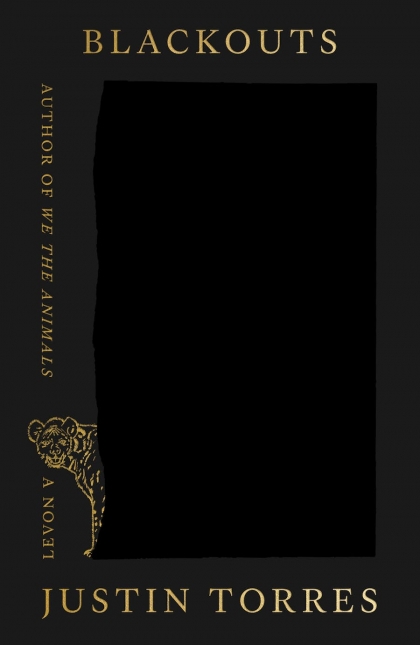Blackouts: A Novel
- By Justin Torres
- Farrar, Straus and Giroux
- 288 pp.
- Reviewed by Carr Harkrader
- November 2, 2023
Queerness and erasure figure heavily in this powerhouse experimental work.

In a book about secrets, the first deception is on the cover. On the cover of Justin Torres’ Blackouts is the label “novel.” But this new work resembles few other novels out there today. Instead, Torres has crafted the fictional narrative of a friendship between two gay men and interspersed it with excerpts from an actual 1941 report on homosexuality whose findings were heavily informed by the real-life Jan Gay, a queer writer and researcher. And it’s all set in a hotel-née-sanitarium in the desert, the Palace.
The report, “Sex Variants: A Study in Homosexual Patterns,” is a topic of conversation between the two main characters: our narrator, an unnamed young man with a rough past, and an older man, very ill and close to death, named Juan Gay. Juan and the narrator had met years earlier at another facility, and their memories are, for various reasons, unreliable. The report, for even more various reasons, is also unreliable. Pages from “Sex Variants” are pasted throughout the novel, with sentences and paragraphs blacked out like redacted excerpts from a classified file. These erasures form their own “terrifying little poem of perversion,” making the visible words resemble something written in tandem by e.e. cummings and Allen Ginsberg.
Torres’ own prose creates a pace like drifting clouds, even as he describes traumatic or painful incidents. And, like watching a cloud, you might blink and suddenly see in it something different. Take, for example, the narrator’s description of his mother:
“[My] mother was a screamer. Nervous, terrified, prone to panic. Though when I picture her screaming, what I see and hear in my mind is a vision from a time well before I was born. She first told me the story when I was a kid, very young — a vivid scene that’s stayed with me, always.”
What starts as a label — a “screamer,” not someone screaming — shifts to a definition and then to a personal touchstone that happened before the narrator existed.
The pages go by similarly, with many holding only an epigraph-length statement or mere paragraph or two. The white space this leaves is its own sort of erasure. As Juan slowly unspools the hidden stories behind the “Sex Variants” study, Torres unmoors the reader from any system of analysis. Unlike the report, which sought to define what queerness looked like in the mid-20th century, Blackouts opens up a questioning ambiguity about how we define any story — any identity — at all.
It’s common to say that writing “weaves together” themes or emotions, but Blackouts is like a piece of wood left splintered. Torres obviously delights in this form, and the book picks at bits of queer implications from art and theater that subverted audiences’ expectations. It also exposes those “experts” who sought to control sexuality by labeling it damaging or linking it to ethnic groups like Puerto Ricans, who were once deemed wild and violently anxious.
Readers’ patience for such intriguing, digressive, confusing, interrupted, and allusive writing may determine their reaction to the book. In my first read-through, I found it both magnetic and (if it’s possible) attractively pretentious. The dying-mentor figure, Juan, was fascinating, but with his portentous statements and endless avoidance of coming clean with the narrator, he seemed like a gay Yoda.
But reading the novel a second time felt like picking up another book. New details stepped out as if from behind a curtain. This time around, the story seemed to be about the perplexing impact of parentage. That’s because Blackouts focuses, in part, on the contributions Jan Gay made to the research undergirding “Sex Variants” and how that work was appropriated by the study’s main (straight) author. Her research was taken from her and grew into something entirely different. But Gay has her own stories, the reader discovers, told within and around her erasure.
And what are families but a collection of stories told to us? What is Jan to Juan and Juan to our narrator (whom Juan affectionately calls “nene,” or little boy)? Some connections are revealed, and some are not.
“This is more than a dream, it is something that is awake within a dream,” Juan says of the tales he’s telling, in a description that could summarize the feeling of the entire book. Torres recognizes playing with silence is a trick that can be done multiple ways. The dark room doesn’t necessarily beg for light.
Carr Harkrader is a writer and book critic in Chicago. You can follow him on Twitter at @CarrHark.

_80_122.png)